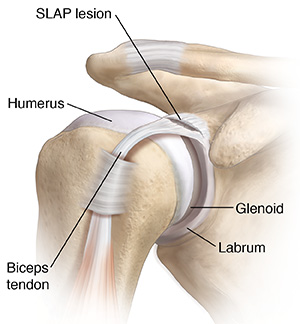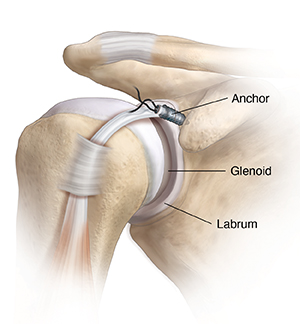A SLAP lesion is a shoulder injury. It happens when there is a tear in the upper part of the labrum. This is the fibrous cartilage that helps hold the shoulder joint in place. Surgery can repair this injury. This surgery may be done through a few small cuts (incisions), called arthroscopic surgery. Or it may be done through 1 larger incision, called open surgery. You and your healthcare provider will discuss which method is right for you.
Preparing for surgery
Do's and don'ts:
-
Tell your healthcare provider what prescription and over-the-counter medicines you take. This includes vitamins, herbs and supplements, aspirin, and ibuprofen. Ask if you should stop taking any of these before surgery.
-
Follow all directions you are given for not eating or drinking before surgery.
-
Bring any X-rays, forms, or scans your provider needs with you to the hospital.
-
Arrange for an adult family member or friend to give you a ride home after the procedure.
During surgery
During surgery, your surgeon will closely examine your shoulder. One or more repairs may be done:
-
The labrum may be reattached to the glenoid using surgical anchors or stitches (sutures).
-
Other damage to the shoulder may be repaired. This includes tightening the capsule. This is the sheet of tough fibers around the glenoid and humerus.
Possible risks and complications of shoulder surgery
Here are some of the possible risks and complications:
-
Infection
-
Bleeding or blood clots
-
Damage to nerves or blood vessels
-
Stiffness or pain
-
Shoulder problem comes back
Featured in



